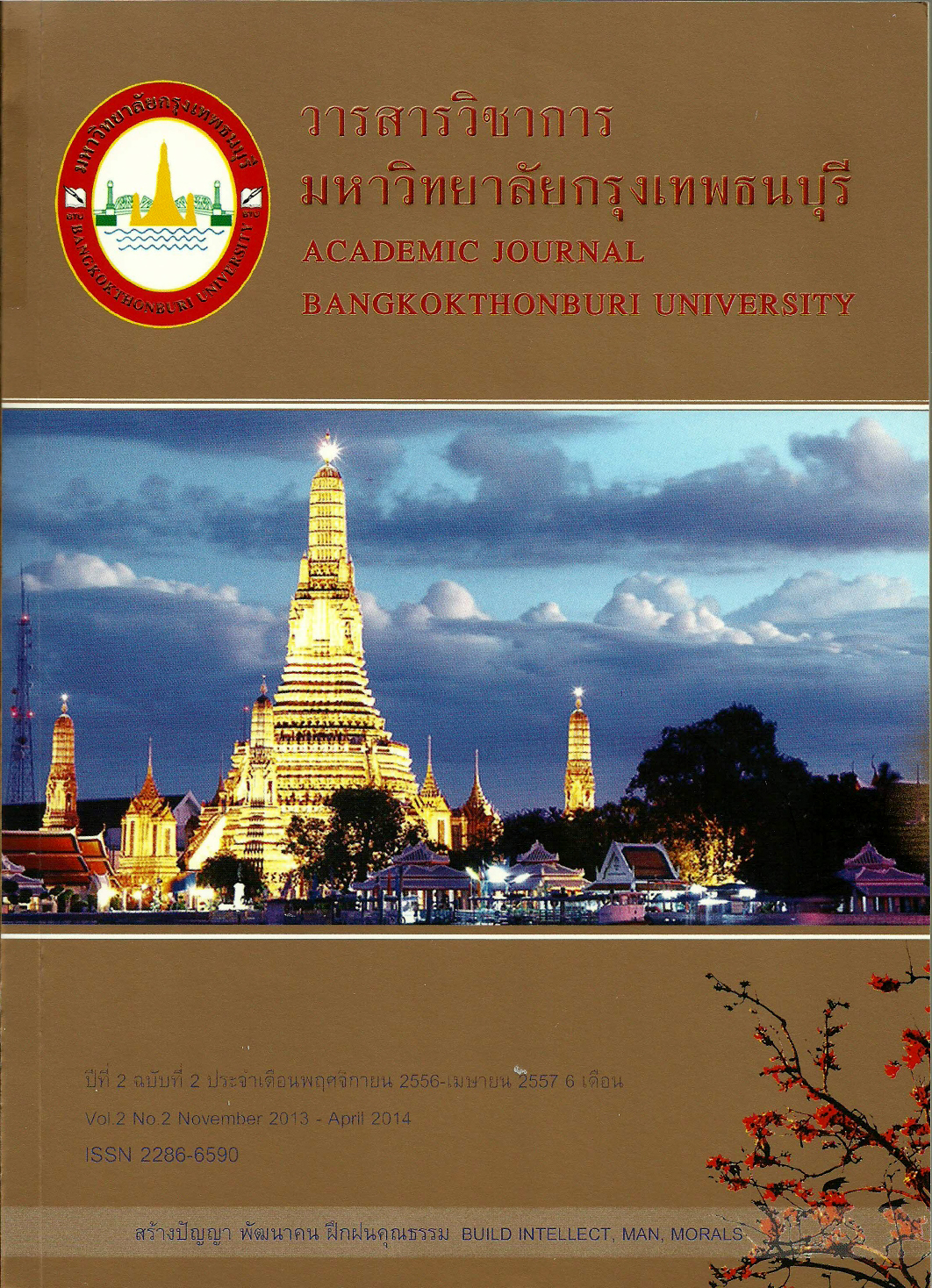โมเดลสมการโครงสร้างตัวบ่งชี้ความสำเร็จการประกันคุณภาพ การศึกษาของคณะวิทยาการจัดการ มหาวิทยาลัยศิลปากร
Main Article Content
Abstract
การวิจัยนี้ มีวัตถุประสงค์เพื่อ ศึกษาการดำเนินงานตามตัวบ่งชี้ของสำนักงานคณะกรรมการ การอุดมศึกษา (สกอ.) และตัวบ่งชี้ของสำนักงานรับรองมาตรฐานและประเมินคุณภาพการศึกษา (สมศ.) และดำเนินการศึกษาความสำเร็จในการประกันคุณภาพการศึกษา ในด้านปัจจัยนำเข้า ด้านกระบวนการ และด้านผลผลิต การประเมินสภาพจริงทางการจัดการคุณภาพการศึกษาด้วยวิธีถ่วงนํ้าหนักพื้นที่โครงข่าย การวิเคราะห์ระบบการจัดการด้วยกราฟตามตัวบ่งชี้ของสำนักงานคณะกรรมการการอุดมศึกษา (สกอ.) และตัวบ่งชี้ของสำนักงานรับรองมาตรฐานและประเมินคุณภาพการศึกษา (สมศ.) เพื่อนำไปสู่การพัฒนา ตัวบ่งชี้ความสำเร็จด้านการประกันคุณภาพการศึกษา รวมถึงตรวจสอบความสอดคล้องกลมกลืนของ โมเดลสมการโครงสร้างตัวบ่งชี้ความสำเร็จการประกันคุณภาพการศึกษา ที่พัฒนาขึ้นกับข้อมูล เชิงประจักษ์ และศึกษานํ้าหนักของอิทธิพลทางตรง อิทธิพลทางอ้อม และอิทธิพลรวมของปัจจัยเชิง สาเหตุที่มีต่อความสำเร็จการประกันคุณภาพการศึกษาของคณะวิทยาการจัดการ มหาวิทยาลัยศิลปากร เครื่องมือที่ใช้ในการศึกษา คือ แบบสอบถาม โดยการสอบถามผู้บริหารและคณาจารย์ เจ้าหน้าที่ สายสนับสนุน นักศึกษา ผู้ใช้บัณฑิตในระดับปริญญาตรี และปริญญาโท และศิษย์เก่าในระดับ ปริญญาตรี และปริญญาโท จำนวน 660 คน สถิติที่ใช้ในการวิเคราะห์ข้อมูลได้แก่ การหาค่าร้อยละ ค่าเฉลี่ย ค่าส่วนเบี่ยงเบนมาตรฐาน และการวิเคราะห์โมเดลสมการโครงสร้าง (Structural Equation Modeling: SEM)
ผลการศึกษาปรากฏว่า โมเดลสมการโครงสร้างตัวบ่งชี้ความสำเร็จการประกันคุณภาพการศึกษา ของคณะวิทยาการจัดการ มหาวิทยาลัยศิลปากร ที่พัฒนาขึ้นมีความสอดคล้องกับข้อมูลเชิงประจักษ์ โดยโมเดลสมการโครงสร้างตัวบ่งชี้ความสำเร็จการประกันคุณภาพการศึกษา ตามตัวบ่งชี้ของสำนักงาน คณะกรรมการการอุดมศึกษา (สกอ.) อยู่ในเกณฑ์ที่ยอมรับได้ (X2 = 550.62, df =277 P = 0.00) และ ค่าดัชนีความสอดคล้อง (GFI = 0.97, AGFI = 0.95, CFI = 0.96 และ RMSEA = 0.044) และโมเดลสมการโครงสร้างตัวบ่งชี้ความสำเร็จการประกันคุณภาพการศึกษาตามตัวบ่งชี้ของสำนักงานรับรอง มาตรฐานและประเมินคุณภาพการศึกษา (สมศ.) อยู่ในเกณฑ์ที่ยอมรับได้ (X2 = 219.98, df =134 P = 0.00) และค่าดัชนีความสอดคล้อง (GFI = 0.97, AGFI = 0.95, CFI = 0.99 และ RMSEA = 0.031) โดยปัจจัยด้านกิจกรรมการพัฒนานักศึกษาเป็นปัจจัยที่มีผลต่อความสำเร็จในการประกันคุณภาพ การศึกษาในด้านผลผลิตสูงที่สุดโดยมีค่าอิทธิพลทางตรงสูงสุด (DE) เท่ากับ 0.89 ทั้งนี้พบว่า หากคณะวิทยาการจัดการ มหาวิทยาลัยศิลปากร จะประสบความสำเร็จในการประกันคุณภาพได้นั้น จะต้องมีรากฐานที่ดีมาจากการมุ่งส่งเสริมกิจกรรมการพัฒนานักศึกษาและการกำหนดวิสัยทัศน์ พันธกิจ เพื่อให้มีการจัดการเรียนการสอนสอดคล้องกับอัตลักษณ์หรือจุดเน้นที่มีคุณภาพมีความเป็นสากลและ เจริญเติบโตอย่างยั่งยืน
Structural Equation Modeling (SEM) of key performance indicator on educational quality assurance of Faculty of Management Science, Silpakorn University
This study aims to: study on operation according to indicator of Office of the Higher Education Commission (OHEC) and indicator of Office for National Education Standards and Quality Assessment (ONESQA) and study on success of educational quality assurance on inputs, processes, products, empirical assessment of educational quality management by weighing network area, analysis of management system by using graph upon indicator of office of the Higher Education Commission (OHEC) and indicator of Office for National Education Standards and Quality Assessment (ONESQA) to development key performance indicators on educational quality assurance to inspect consistency of developed Structural Equation Modeling (SEM) of key performance indicator on educational quality assurance with empirical data; and to study on weight of direct effect, indirect effect and total influence of casual factors on success of educational quality assurance of Faculty. Tool used in this research was questionnaires completed by 660 samples of administrators, teachers, administrative staffs, students, graduate users in undergraduate and graduate levels, and alumni in undergraduate and graduate levels. Statistics used for data analysis were percentage, mean, standard deviation and a group of statistical in Structural Equation Modeling (SEM).
The results showed that developed SEM of key performance indicator on educational quality assurance of Faculty of Management Science, Silpakorn University was consistent with empirical data. SEM of key performance indicator on educational quality assurance according to indicator of Office of the Higher Education Commission (OHEC) was acceptable (X2 = 550.62, df =277, P = 0.00) with Index of Consistency (GFI = 0.97, AGFI = 0.95, CFI = 0.96 and RMSEA = 0.044). In addition, Structural Equation Modeling (SEM) of key performance indicator on educational quality assurance according to indicator of Office for National Education Standards and Quality Assessment (ONESQA) was also acceptable (X2 = 219.98, df =134, P = 0.00) with Index of Consistency (GFI = 0.97, AGFI = 0.95, CFI = 0.99 and RMSEA = 0.031). Factor on student development was the factor with the most influence on success of educational quality assurance on product with the highest level of direct effect (DE) at 0.89. As a result, If Faculty had to have good foundation on promoting student development to achieve educational quality assurance. In addition, they had to establish their vision and mission to provide instruction corresponding with quality, international and sustainable identity and main emphasis as well.


